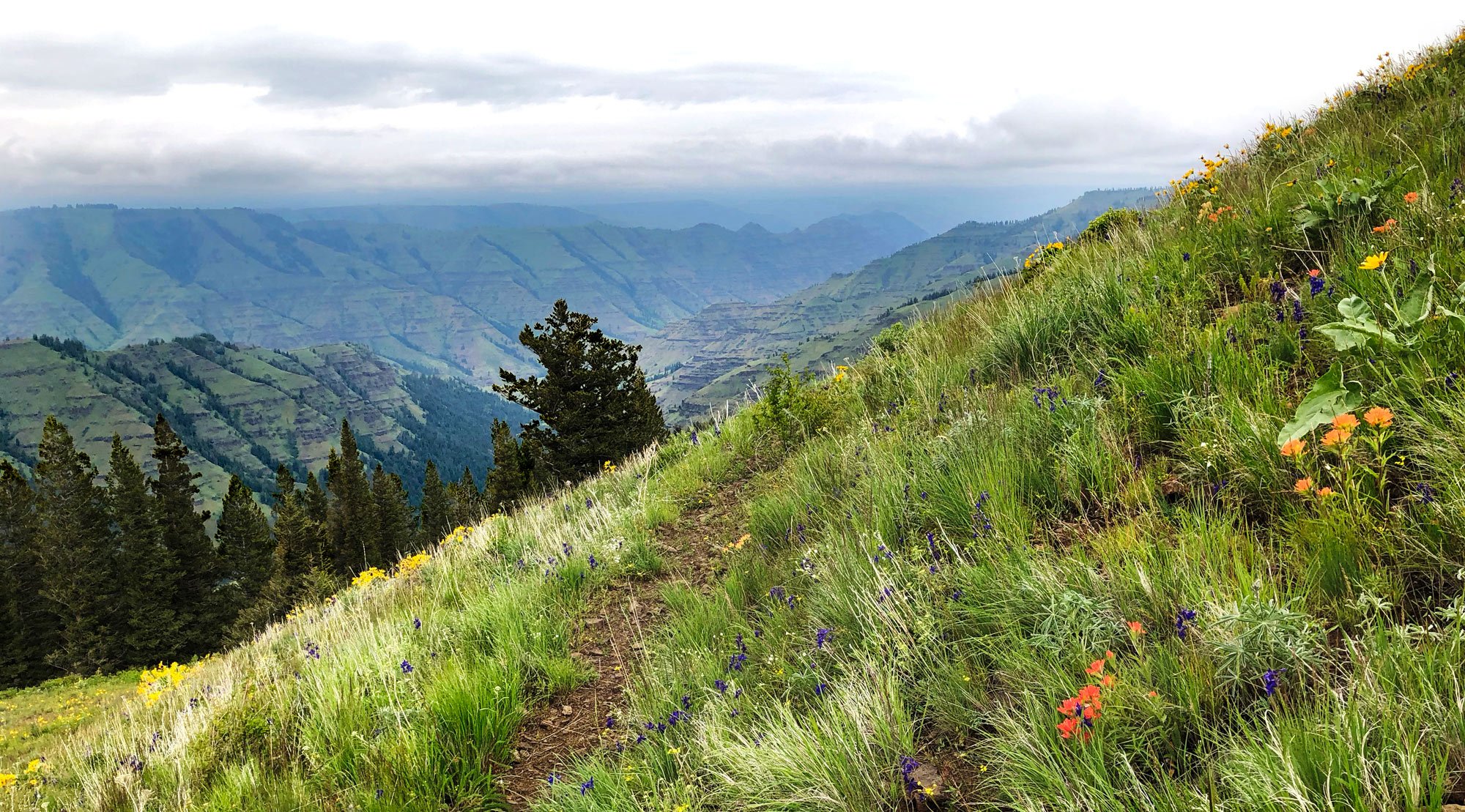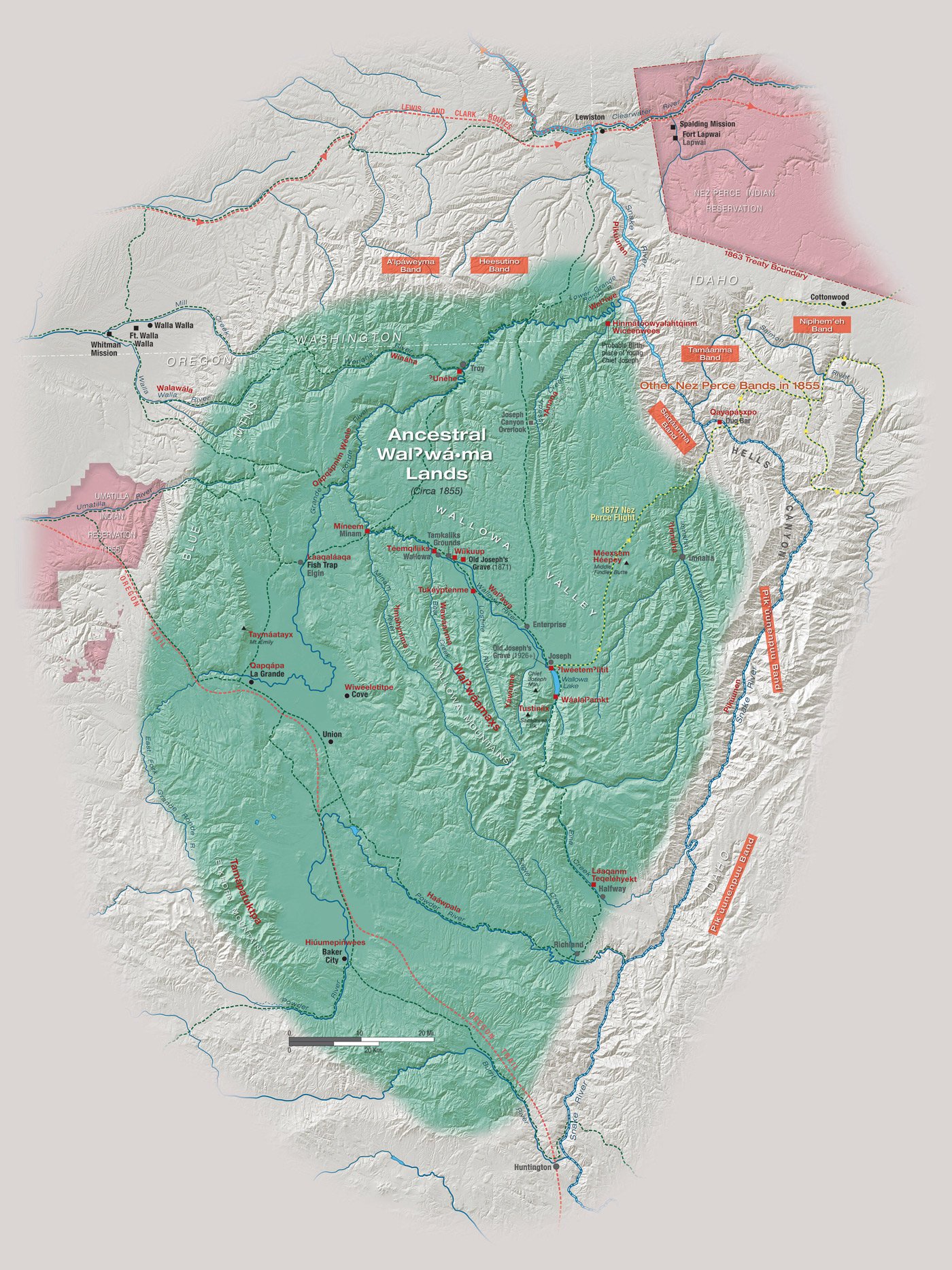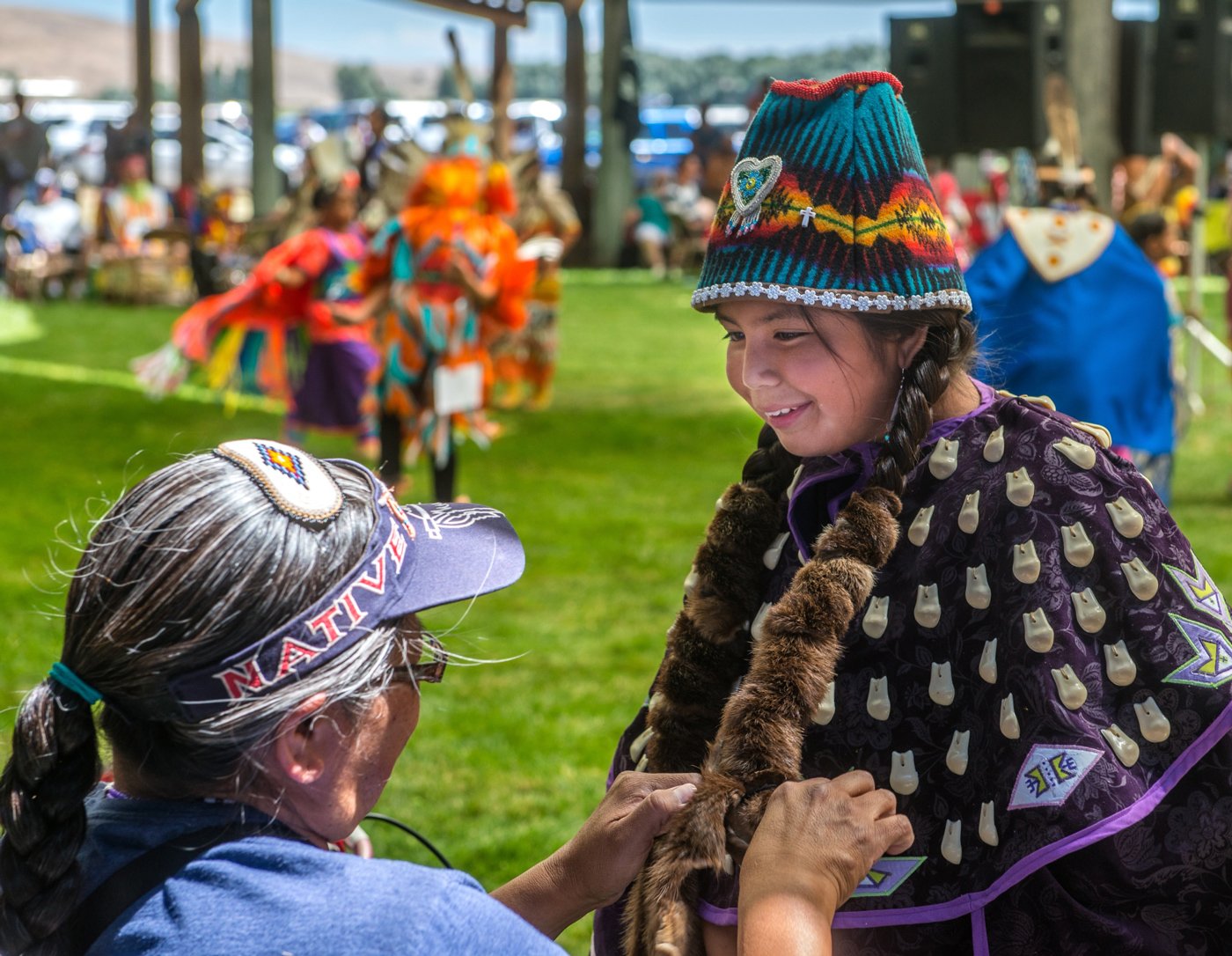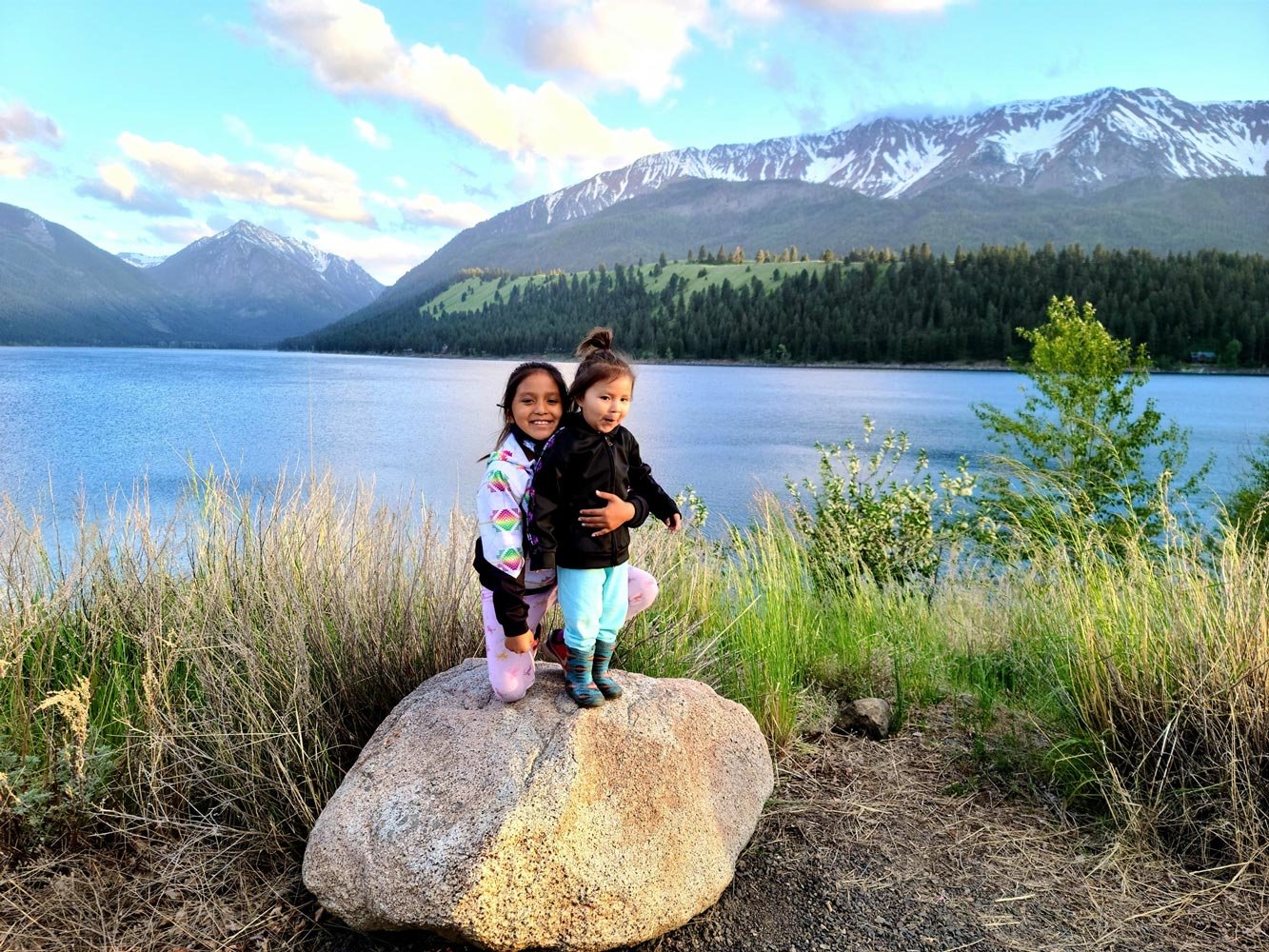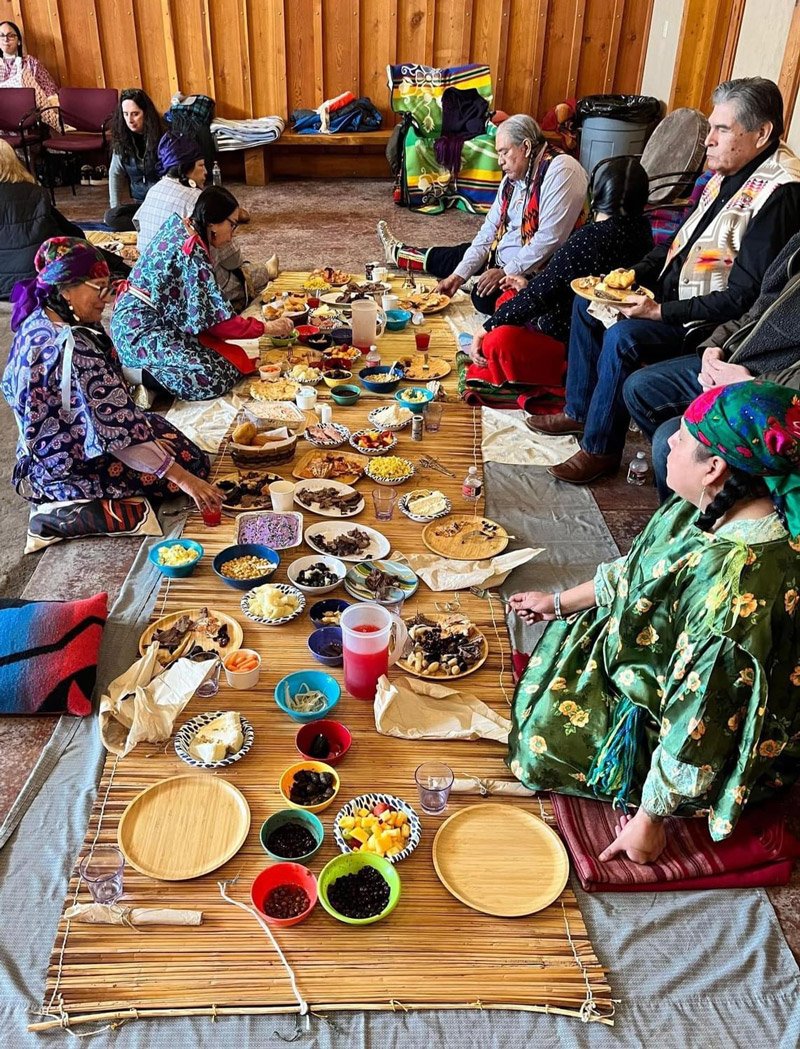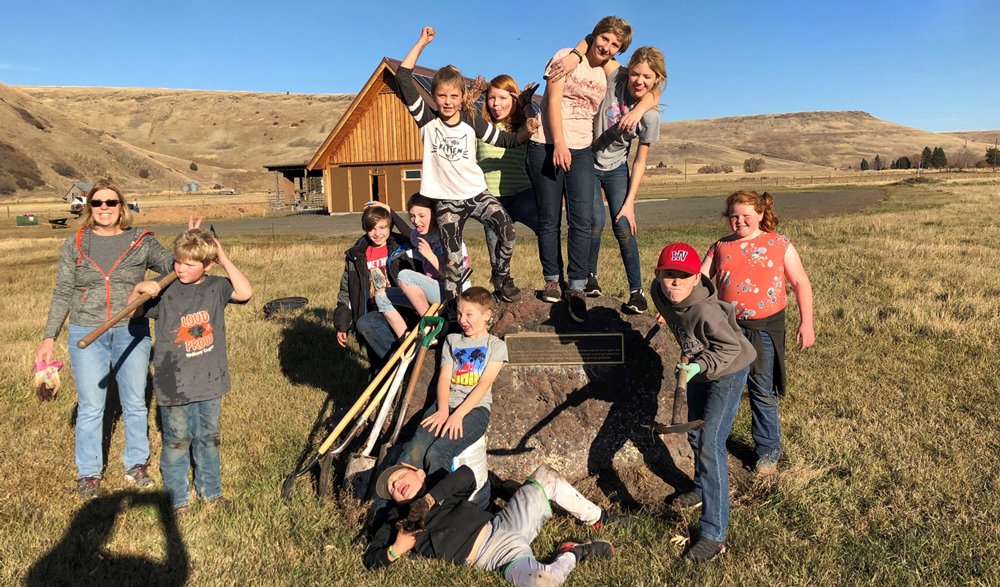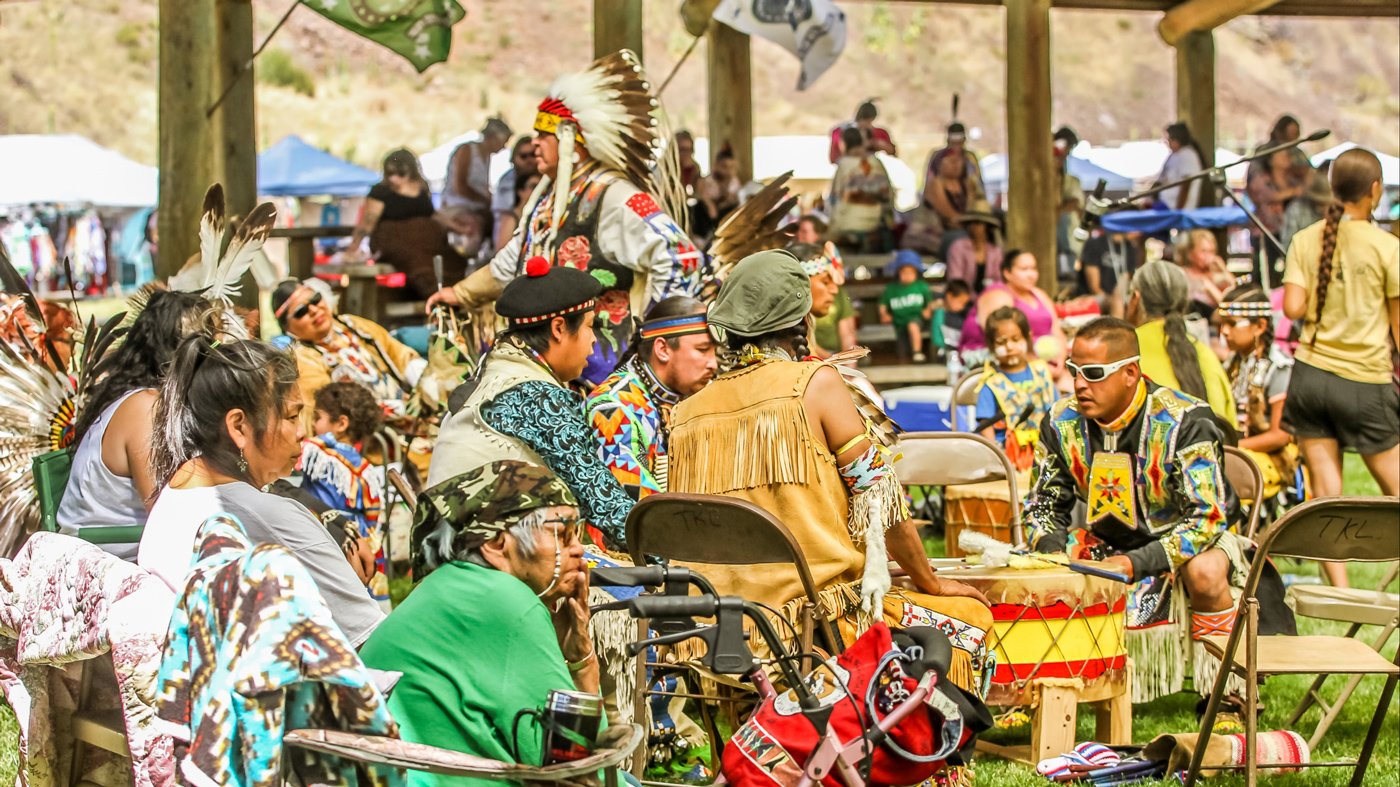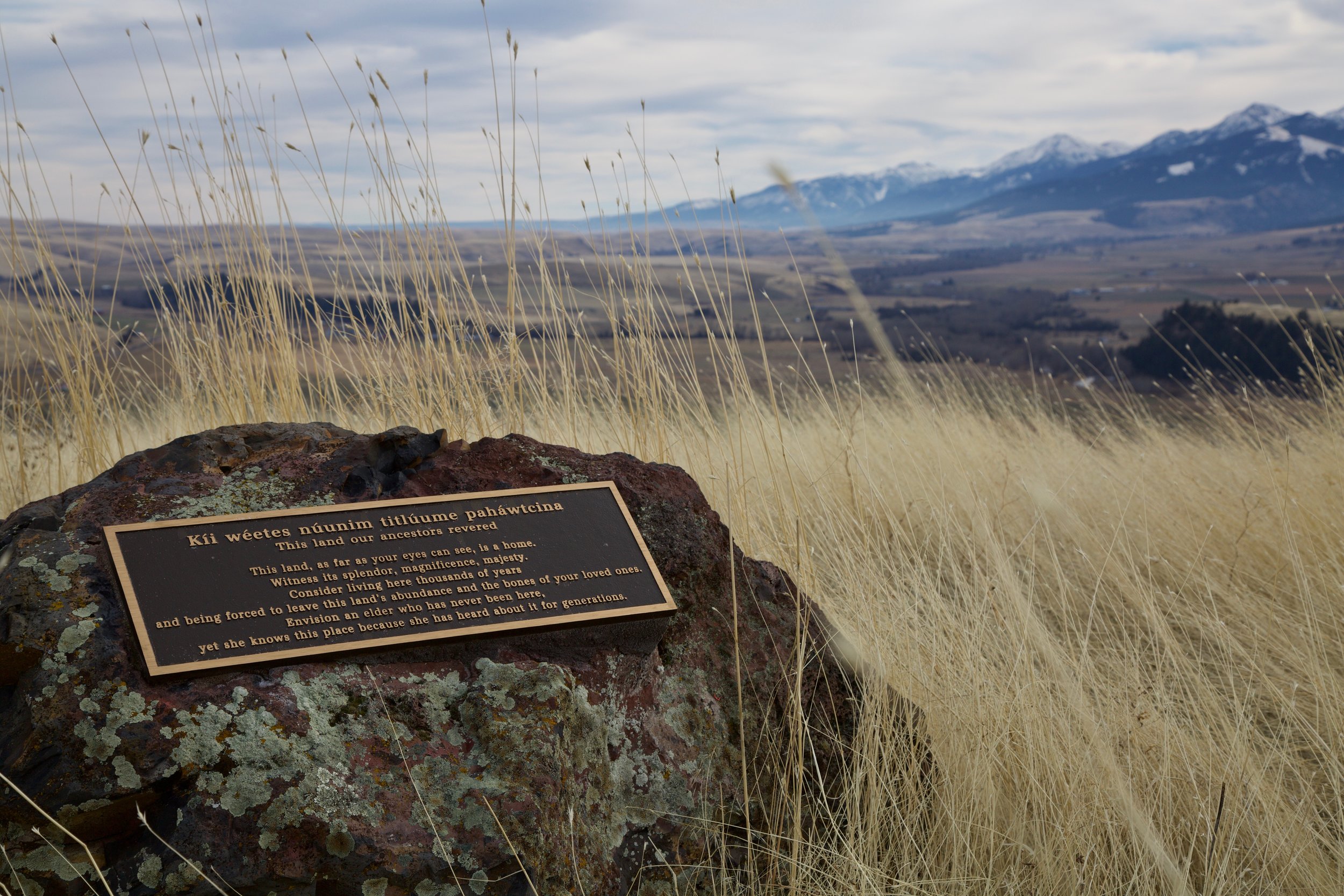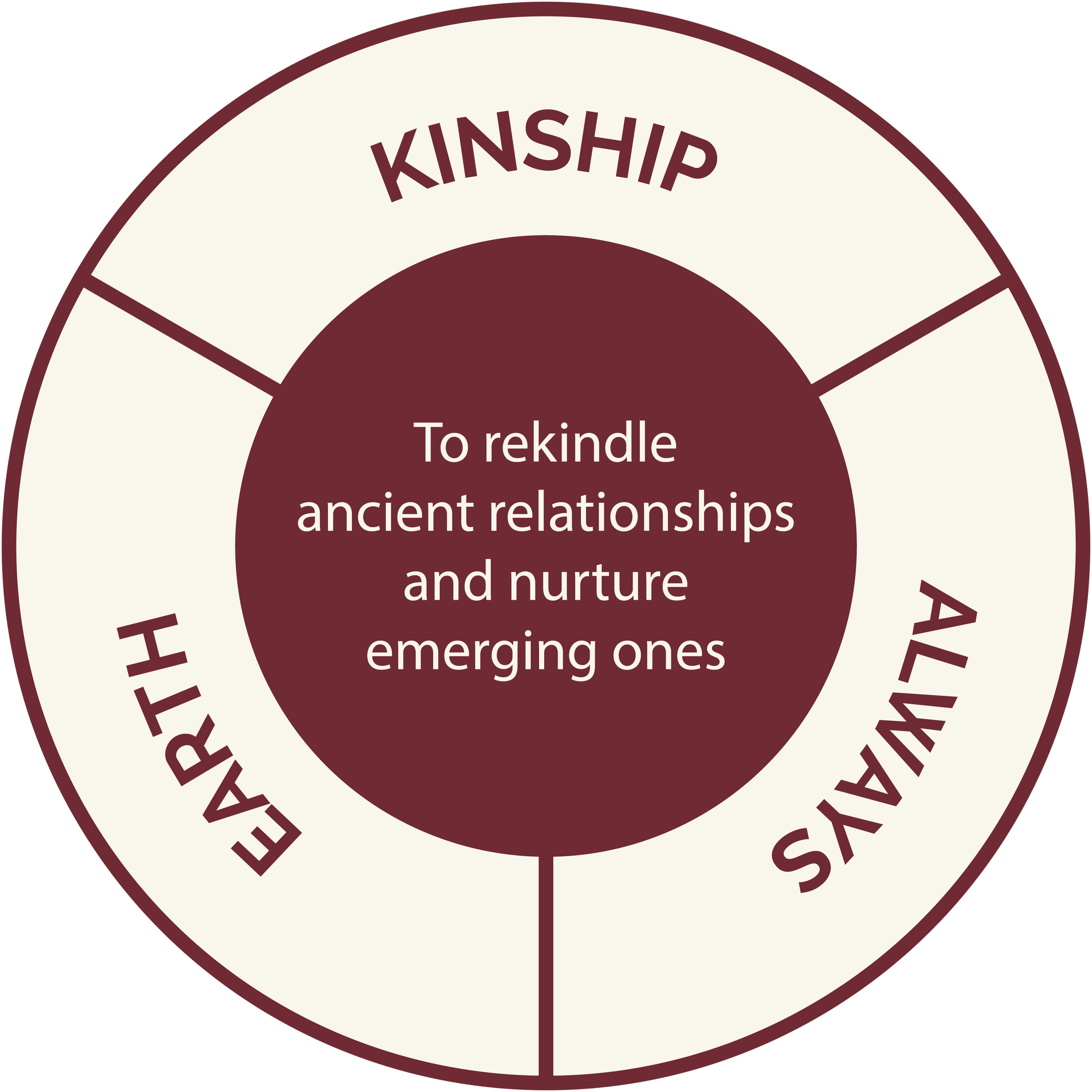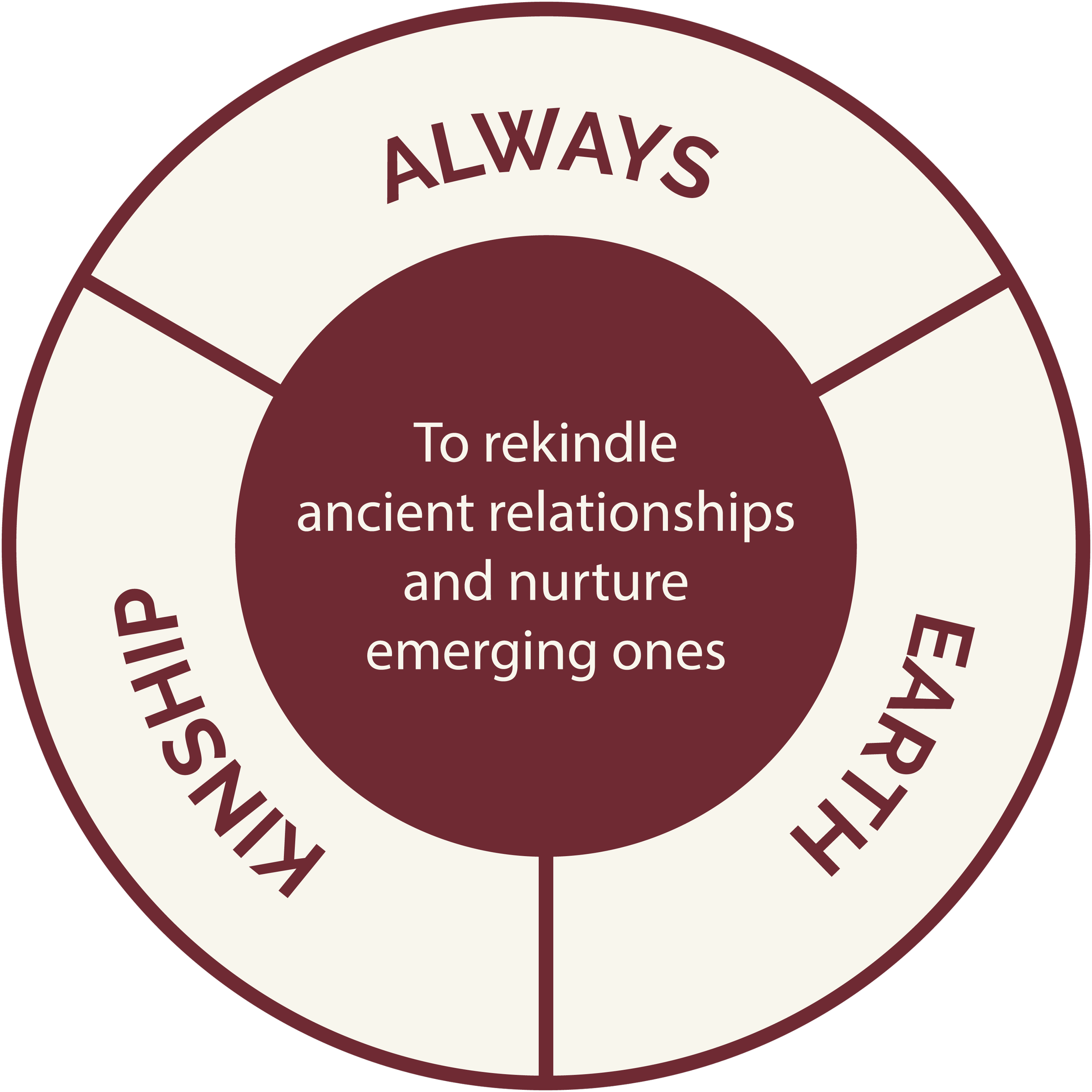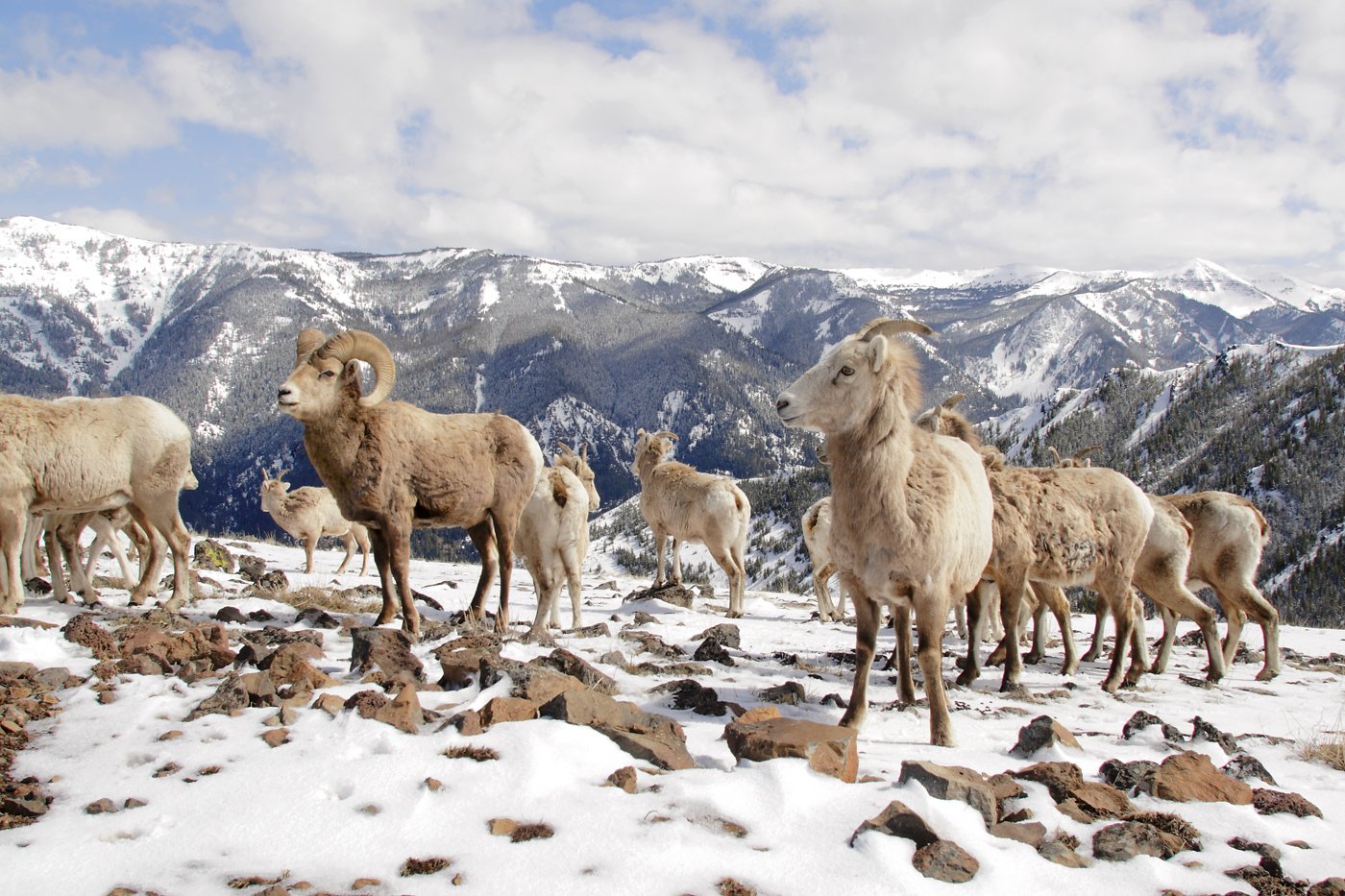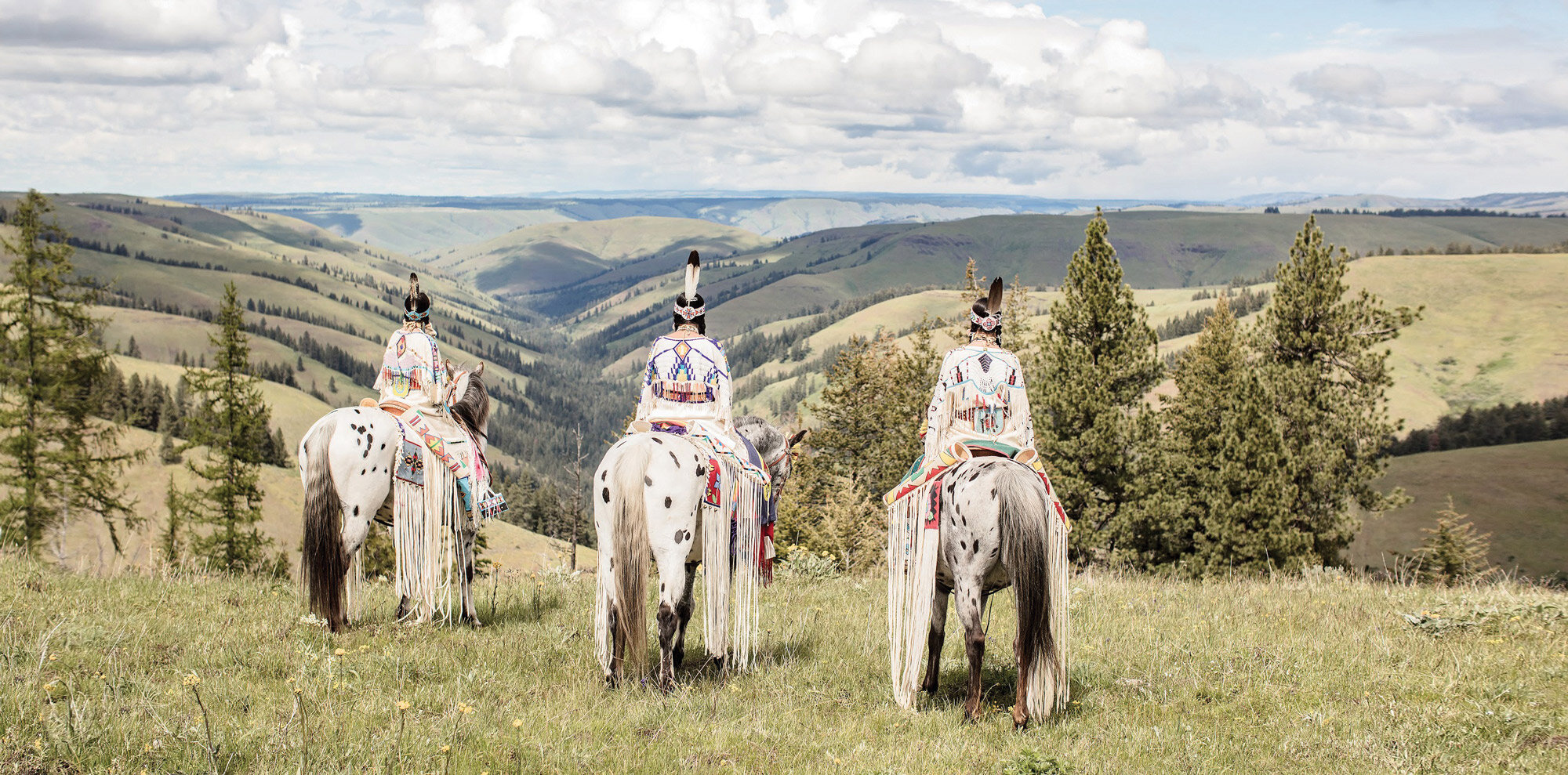
WE ARE OF THIS LAND
— hinmató•wyalahtqit
Who We Are
Nez Perce Wal’áwa Homeland is led by tribal and non-tribal people with a common commitment to upholding, perpetuating and celebrating the people and practices native to wal’áwa; our shared home.
ku wéetes hitqewc’éeye hete’éwnix ke’imée kíne hiwsíine
People who care about this land
Our Vision
We envision kinship among land, water and beings of wal’áwa restored, celebrated and lit up.
wé·tesne (the land) and people together maintaining titoqanwí·tki· (native culture) in the way titlúme (ancestors) had intended.
Our Guiding Values
The teachings of tamá•lwit show us how to live in reciprocity with our relatives of the land and water. This principal provides the framework for how we at Nez Perce Wal’áwa Homeland think about relationship building, generational succession, land stewardship and our daily operations. To put those teachings into practice, we define six values embodied in tamá•lwit to guide our work.
SHARING
We seek a right way of working together by respecting the love that people past and present have for wal’áwa, and remembering the ideas we’ve been given by our predecessors.
CELEBRATION
We find joy in time spent together on the land, in cultural practice and in planning for a better future together.
RECIPROCITY
We take care of each other.
RESPONSIBILITY
We take responsibility for one another and honor this sacred home.
Trust
We recognize that renewing relationships requires honesty and vulnerability, and we are invested in the slow work of listening, repairing and relearning.
COURAGE
We take on the complexities of our shared history with the courageous intent to open up dialogue and move toward healing.

IT IS TIME ONCE AGAIN TO LET THE LAND HEAR THE FAMILIAR SOUNDS
that have been developed over thousands of years here in the land of winding waters — the rhythm of the drum beat, the songs, the language, the prayers, the people, and all creation joined to co-exist and respect mother earth and this law of the land. — Taz Conner, 1994
Our Mission
Our mission is to deepen the connection between the wal’áwa country and all those who care about it. We inspire a way of working together as wé·tesne qicxnew̓é·t (caretakers of the earth) to rekindle relationships and welcome people home.

THE SPIRIT OF THAT PLACE, YOU CAN STILL HEAR IT AND FEEL IT.
When you’re in the mountains or on the rivers or at the grounds, or when they’re having services — it’s like those lands wake up. — Carla Timentwa
Our Story
Nez Perce people have always stewarded and lived with the lands now called Wallowa County. This way of life was interrupted in the early 1870’s when the valley was settled and respected wal’wá•ma leader and elder tiwi•teqis’ passed on. His son hinmató•wyalahtqit went on to lead the people of wal’áwa through the events of 1877 and beyond, when the wal’wá•ma band was removed, scattered and exiled. Our organization exists to remedy the bonds that were broken through these events, and to be part of a new story that tells of connection, synergy and resilience. To learn more about Nez Perce history, and particularly the wal’wá•ma, explore our Virtual Tour and the Recommended Reading (Appendix E).
Today, descendants of this ancestral home live on the Umatilla, Nez Perce and Colville Indian Reservations, as well as at Yakama, Warm Springs and as far away as Canada. We, the Nez Perce Wal’áwa Homeland, are a coalition of tribal and non-tribal individuals with shared values and a shared love of wal’áwa. We work together in support of the descendants of the wal’wá•ma band of Nez Perce, who are a part of this place and whose presence is essential for the well-being of all.

IT HAS FALLEN UPON THE SHOULDERS OF THIS GENERATION
to capture the history and, through cultural understanding, respect this land that we live in. We all came together at this historical location to extend our concerns for a better world by maintaining for future generations the knowledge that made this land a wonderful place to live. — Taz Conner, 1994
When the ancestors lived here, people of many tribes came to this area to gather foods, trade and camp. Although very few tribal people live in Wallowa today, people have not forgotten that this place, wal’áwa, is home. In 1989, Taz Conner, a wal’wá•ma descendant, joined with members of the Wallowa city council to host a cultural celebration planned by and for tribal people who wished to sing, dance and feast in their ancestral homeland. The draw of the wal’áwa homeland is strong, and interest has grown such that today the 323-acre celebration grounds is host to the annual Tamkaliks Celebration as well a traditional longhouse, trails, campground and housing. The downtown office space and visitor center are managed by local staff and governed by board members hailing from the Wallowa Valley and tribal communities across the northwest. Learn more about the founding of our organization in the Foundation Document (Appendix F).
The Nez Perce Wal’áwa Homeland provides much more than a place to reunite once a year. The comforts of our facilities and hospitality of friends and colleagues offer a warm welcome to dispersed descendants of the wal’wá•ma and all who seek to connect with and honor this home. Together we work to amplify the light shining from this land, as a beacon to those returning and an instructor for those who live and work upon it. Through the practice of Indigenous lifeways in the wal’áwa homeland — feet touching the earth, foods being gathered, language being spoken, songs being sung, plant and animal relatives being honored and protected and fragmented communities coming home in friendship — health and healing are restored to land, water and people.

TAMKALIKS IS THE SIZZLE ON THE STEAK
But it's just the sizzle … we spend a lot of time and energy and resources making Tamkaliks happen, but it's bait. From the perspective of the people who founded this event, it was the idea that if we could do something that drew the Wallowa Valley community together with tribal people from the Umatilla, Colville and Nez Perce reservations, we could build bridges … we might heal wounds. If we could pull this event off, it might give people a reason to come here and be happy and not sad. If the event was successful, it might cause us to reintroduce Nez Perce culture back into the landscape … And that for me is the reason we do it. — Bobbie Conner, 2021
For thirty-two years and counting, building a place of homecoming has been the central goal of the Nez Perce Wal’áwa Homeland. Volunteers, supporters, staff and professionals have shown up and worked hard, for decades. In doing so, we have not only built an amazing place with unparalleled amenities, but we have shaped an organization founded on tenets of trust, sharing and responsibility. It has not always been easy, but caretaking the grounds together has effectively strengthened our bonds of kinship and stewardship. We see history being made in the present. We lift each other up to ensure the future we are inspiring is a vibrant, safe and happy one. This dynamic and flexible organization is well-equipped today to grow our impact. We are stepping into the next ten years not only as a place to gather, but as a hub for people to connect with each other and the entirety of the Wallowa country.
Our Strategic Planning Process
Since the incorporation of the Wallowa Band Nez Perce Trail Interpretive Center (WBNPTIC), now known as the Nez Perce Wal’áwa Homeland, there has been a continuing precedent to gather input from participants across three regional reservations and among Wallowa County residents. A variety of formal documentation from the early days of this project have informed this Strategic Plan, as well as the minutes from Annual Planning Meetings dating back to 2005. Focus groups were held in 2015 at all three reservation locations, and staff-led planning sessions in March of 2018 and March of 2020 generated further insight about tribal and non-tribal perspectives on the priority work of this organization, as it pertains to interpretation, programming, mission, vision and day-to-day activities. Reports and records from the efforts described above are available to all, and are filed in the office and online as “Strategic Plan Source Documentation.” A Strategic Planning committee convened in March of 2022, with representation from all three reservations and Wallowa County, to guide the drafting of this document. The Action Plans and Resources found in the Appendices are subject to regular updates as approved by the Executive Committee of the Board of Directors.

THERE WERE MANY BANDS OF NEZ PERCE. AFTER THE “WAR” OF 1877, WE BECAME A VERY DIVIDED PEOPLE...
These splits are very evident still today. In defining our goals for the Wallowas, we must also try to understand the differences between a common people … When we sit down to plan, let us not only think about ourselves, but the generations yet to come. — Keith “Soy” Redthunder
Our Three Goals
wéete qicx̣new’éet : Caretake the Earth
himiyunéewit piiwatíiqahalkt : Reciprocal Relationships
kúnk’u wax̣ kúnk’u : Continue Always and Forever

TO KNOW WHERE YOU ARE GOING YOU MUST KNOW WHERE YOU COME FROM.
— Charles Sams III
Goal
wéete qicx̣new’éet
“Caretake the Earth”
Goal: Together, steward land and water across Wallowa country
Within 10 Years: The 323-acre celebration grounds in Wallowa is exemplary in regenerative management.
Within 30 Years: Landowners and tribal families are working together to repatriate acreage throughout Wallowa County, furthering Indigenous private land ownership and participation in local governance.
Within 100 Years: Stewardship of Wallowa lands, both public and private, is a collaborative and inclusive act that is reflected in the abundant health of the ecosystem here.
Strategies and Tactics:
-
Respect and restore waterways and wetlands
Establish and maintain an annual action plan. Appendix A: Grounds and Facilities Plan
Lead through example:
Holistically manage invasive plant species
Nurture native and pollinator-friendly plant species
Protect wildlife especially during key seasons
Remove barriers and offer built habitats for fish, birds, etc
Monitor and address soil health
-
Welcome diggers and gatherers to take care of plants that provide roots, berries, medicines and materials
Engage local community in volunteerism to sustain land management activities at the celebration grounds and beyond
Build relationships with landowners of properties where key plants and wildlife are found. Facilitate tribal engagement in accessing, protecting and restoring gardens.
Involve youth, always. They inherit this land.
-
Lead with shared values and organize around common intent to provide tribal access, steward land and protect ecosystems
Educate and influence local organizations and agencies to expand consultation to include Wallowa Band Nez Perce
Influence paradigm shift of local organizations and agencies away from a need for control and toward embracing Indigenous-led solutions
Support and synthesize tribal engagement efforts of organizations operating in Wallowa County to reduce distraction, focus efforts, pool resources and streamline communication
Goal
himiyunéewit piiwatíiqahalkt
“Reciprocal Relationships”
Together, promote Nez Perce presence, relationship and belonging across Wallowa country
Within 10 Years: A variety of events and services establish an accessible pathway home for generations to come.
Within 30 Years: Indigenous people of this valley increasingly reside, raise families, work, celebrate, practice culture and walk the land here in wal’áwa.
Within 100 Years: Abundant cross-cultural relationships are rooted in shared understanding and mutual respect for history and tradition.
Strategies and Tactics:
-
Provide reasons for people to come to Wallowa and feel happy, not sad; to lay down hurt and trouble and celebrate being at home
Foster experiences for youth that spark an enduring love for the Wallowa homeland
From beginning to end, involve Indigenous teachers and knowledge keepers in program planning and execution
Connect tribal people with the experiences, people and resources necessary to access and influence Wallowa country
Collect and archive pertinent records and communicate with people about their ties to Wallowa
Establish and maintain an annual action plan. Appendix B: Engagement Plan
-
Provide a platform for teaching and learning
Honor educators for their cultural knowledge
Celebrate Indigenous ways of knowing
Seek opportunities for shared learning
Create and share teaching and learning materials
-
Design shared community spaces to encourage collaboration
Host shared meals to connect humans with humans
Bring people together here where a shared love of Wallowa perpetuates healing
-
Orchestrate events that bring people together
Provide a variety of offerings for inclusivity and welcome to all
Celebrate specific and distinct cultural aspects, as well as broader cultural preservation. Both depth and breadth matter.
Encourage dialogue among people of different faiths, priorities, experiences and histories
-
Logistical barriers
Provide information resources for employment, housing, healthcare, education, hunting, gathering, recreation, government and current events
Offer services to support home ownership
Economic barriers
Subsidize travel costs by providing services: lodging, horse corrals, camping
Influence local organizations to include and positively impact tribal people
Facilitate economic development that creates job opportunities in Wallowa
Social barriers
Inform and engage the general public, especially youth
Use facts to dispel colonial constructs and stereotypes
Pursue truth and reconciliation at a local level Strive for mutual respect and appreciation
Goal
kúnk’u wax̣ kúnk’u
“Continue Always and Forever”
Plan for perpetuity, together
10 Years, 30 Years and 100 Years: Cultivate, maintain and expand the connections, skills, resources and physical spaces essential to ongoing pursuit of the mission.
Strategies and Tactics:
-
Establish and maintain an annual action plan. Appendix C: Development Plan
Invest in staff and board professional development
Trainings
Retreats
-
Learn how the communities we serve perceive our work
Clearly communicate who we are and what we do
Establish and maintain an annual action plan. Appendix B: Engagement Plan
Personally engage current and prospective board members
Make introductions, build a network
Engage communities where they are, using snail mail to Facebook to in-person visits
-
Invite all parties without bias
Show up
Follow the lead of indigenous participants Listen to elders.
Listen to youth. Listen to all.
Allow space for everyone to contribute
Show hospitality
Appreciate experiences of others
Strive for consensus
Have uncomfortable conversations
Proceed together
Do the work
Welcome opportunities to learn
-
Review and amend Strategic Plan by committee every three years
Regularly monitor, evaluate, adapt
Develop and proceed with a board approved annual work plan. Appendix D: Staff Work Plan
-
Maximize appropriate uses of facilities, perform regular maintenance and update and improve as needed
Reach more people who will benefit from available facilities
Leverage underutilized assets to meet needs of tribal and local communities
Design classroom spaces
Welcome cultural practices with specific facilities for horses, worship, food preparation, etc
Provide work spaces
Expand housing capacity and flexibility
Identify potential partnership and income opportunitie
Build new amenities essential for priority programming, ie
Sweat Lodge
Basketball Court
Proceed with a maintenance plan in place. Appendix A: Grounds and Facilities Plan
Thank You
The Nez Perce Wal’áwa Homeland receives strong local and regional support. Contributors include individual citizens, private foundations, the Nez Perce Tribe of Idaho, Confederated Tribes of the Umatilla Indian Reservation, Confederated Tribes of the Colville Reservation, the National Park Service and the USDA Forest Service.
Complete List of Public and Private Funders
See Development Plan (Appendix C)
2019-2022 Capacity Building Funders
Oregon Community Foundation
Collins Foundation
2023 Operational Support
National Endowment for the Arts
Oregon Humanities
Inatai Foundation
Seeding Justice
Roundhouse Foundation
Board of Directors
Visit our Board Page
2023 Staff
Staff Page
An incomplete, ever-growing list of those who have given so much of themselves to this project.
Adele Guyer, Albert Andrews Redstar, Alice Parman, Alvin Josephy, Andrea Axtell, Amelia Marchand, Andrew Wildbill, Ann McCormack, Armand Minthorn, Beaulah Wynans, Ben Boswell, Lukas Angus, Bud Phillips, Bessie Scott, Betty Conrad, Bill Fisher, Bill Timentwa, Bob Williams, Bobbie Conner, Brenda Axtell, Brian Conner, Brian McCormack, Bruce Coutant, Cindy Fine, Bud Fischer, Cameron Albee, Carl Sampson, Angelika Ursula Dietrich, Carla Marconi, Carla Timentwa, Cathy Quistgard, Cece Whitewolf, Charlie Moses Jr., Margaret Moses, Charlotte Watters, Chris Geyer, Christopher Williams, Dave Clark, Dave Flynn, Dave Gilbert, David Smythe, Debbie Carson, Deborrah Reth, Dee Penney, Don Green, Don Stein, Donovan Shaw, Doug Chrisman, Douglas Marconi Jr., Earl ‘Taz’ Conner, Ed Chiffons, Eddy Adams, Elena Basset, Elwayne Henderson, Eric Carlson, Etta Conner Scott, J Johansen, Liam Slater, Lloyd Pinkham, Clark Schimeall, Allan Pinkham Sr., Allan Pinkham Jr., Josiah Blackeagle Pinkham, Jim Franey, Joyce White, Florene L. Davis, Frank Walker, Fred Hill, Gabrielle Moses, Jenner Hanni, Glen McDonald, Gordan Higheagle, Grace Bartlett, Horace Axtell, Irvin Watters, Connie Watters, Jack Conley, George and Helen Gabriel, James Lawyer, Jamie T. Williams, Angela Bombaci Harvey, Jason Crenshaw, Jesse Leighton, Jim Chapman, Jo Hallam, Jodi Conner, Joe McCormack, Joe Whittle, Jon Rombach, Jon Yearout, Kathy Willett, Katie Harris, Kendall Clark, Kirk Skovlin, Camille Crenshaw, Kristin Albee, Leah Conner, Leita Barlow, Steve Grant, Milley O’ Callaghan, Liam O’ Callaghan, Linda Jones, Angel Sobotta, Linda Sue Lewis, Linda Watters, Leslie Moses, Lisa Lang, Milton ‘Jewie’ Moses, Loretta Halfmoon, Louie Dick, Maggie Conley, Mamie McCrae, Marie Marek, River Whittle, Marty Davis, Mary Hart, Mary Hawkins, Mary Knutson, Matthew Jensen, Melanie Crenshaw, Michael McFarland, Michelle Perales, Mikey Penney, Jean Grandy, Lee Perkins, Nancy Crenshaw, Terry Crenshaw, Nancy L. Broncheau, Nancy Lincoln, John Hillock, Nola Colvin, Norman McCrae, Larry Forsgren, Paul Henderson, R.D. Carson, Ralph Anderson, Ralph Swinehart, Randal Minthorn, Rich Wandschneider, Rick Swart, Rob Lamb, Jane Harshman, Rodney Cawston, Ron Cameron, Ron Peterson, Ronald Halfmoon, Rosa Yearout, Liam Roy Hellwig, Sally Carlson, Sara Averbeck, Sara Miller, Sharon Redthunder, Sid Roberts, Sidney Austin, Silas Whitman, Skip Novakovich, Pistol Pete Wilson, Larry Green Jr., Skip Royes, Soy Redthunder, Star Longley, Steve Axtell, Susan Sprague, Suzanne Smith, Tessie Williams, Tom Hampson, Verl Lewis, Wilfred Scott, Woodrow Star
Contact information
Nez Perce Wallowa Homeland Visitor Center
209 East Second St., Wallowa, OR 97885
541.886.3101, info@wallowanezperce.org
The Homeland
70956 Whiskey Creek Rd., Wallowa, OR 97885
Open to the public dawn to dusk, seven days a week (except during special events)
Map of grounds
Link to Visit Us Page
Appendices
Appendix A: Grounds and Facilities Plan
Prepared annually in the fall by the Grounds and Facilities Committee.
The Grounds and Facilities Plan will provide a three, five and ten year outlook on management of the grounds and all facilities owned by the Nez Perce Wal’áwa Homeland. Property and assets will be broken out into zones, with public usage and management concerns, priorities and goals identified for each zone.
Topics considered in this plan will include:
Vegetation (Plantings, trees, weeds, haying, grazing, irrigation)
Access (fencing, roads, trails, vehicles, horses, recreation)
Habitat (Restoration, protection)
Facilities (Maintenance, new construction, safety, utilization policy & procedures)
Interpretation (signage, public engagement, programming)
Appendix B: Engagement Plan
Prepared and updated in January of each year by the Engagement Committee.
The Engagement Plan will describe NPWH outreach and marketing strategies, and maintain a yearlong outlook on all programs developed, presented, administered and hosted by the Wal’áwa Homeland.
Topics considered in this plan will include:
Confirm organizational name, vision and mission statements and tagline
Identify target audiences
Describe our goals for public perception
Establish a branding ‘style guide’ including key language usage, fonts, colors and logo
Plan promotional materials including website, brochures and newsletters
Plan publicity avenues and categories of communication, and set goals for outreach
Print publications
Online publications
Social media
Set goals for community partnerships
Set goals for participation, including volunteerism and board membership
Include a table of National, Regional and Local media outlets, contacts and publishing schedule
Create 12 month calendar. All programming development, planning, funding, and implementation benchmarks will be broken out into monthly tasks, including:
Contact information & Program Dates (for partners and programs hosted by our facilities)
Program Funding (grant application deadlines, fundraising events & campaigns, etc.)
Administrative Tasks (marketing deadlines, scheduling meetings, etc.)
Program Needs & Site Preparation (gathering materials, preparing facilities & sites, coordinating transportation, curriculum development, etc.)
Post-Program/Wrap-Up (grant reporting, cleaning facilities, program reflections/revisions, etc.)
Appendix C: Development Plan
Developed in 2023 and updated every year by the Development Committee.
A committee of Board and Staff will review and update the Development Plan each year in January to align with organizational finances & programmatic goals for that year. The Development Plan will describe fundraising strategies and goals using a structure that makes sense for the board of directors, organizational finances, programmatic goals and fundraising trends at that time.
The Development Plan will include:
A Board Fundraising Model Structure that has been approved by the board of directors
A financial review of the previous two years that includes: profit & loss statements, a written statement of financial position
Analysis of fundraising efforts from the past two years
Organizational annual budget
Program goals for the next 1 and 2 years, and projected associated expenses
Identified fundraising strategies, goals, & tactics
Financial goals by revenue source (includes earned income, sales, donations & grants)
Donor stewardship: target audiences & goals for participation
Timeline for each strategy, including benchmarks
Resources needed for each strategy
Who will participate? (list of staff, board, volunteers involved)
Projected expenses (supplies, administrative time, advertising, etc)
Appendix D: Staff Work Plan
Prepared annually by Staff.
The Staff Work Plan will be presented to the Executive Committee during the first committee meeting of each year. It will demonstrate the steps that staff will take throughout the coming year to implement tactics as outlined in the Strategic Plan. The plan will be broken down by project/program and staff member/s responsible, and will include a timeline of tasks, activities and fundraising needs for the year.
